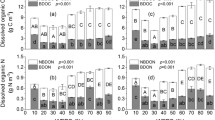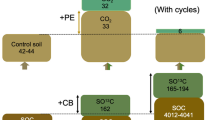Abstract
This study investigated the effects of the freezing and thawing that accompany the warming process on the composition of the soil organic matter in the dissolved and colloidal fractions. Temperate soil samples were incubated in a refrigerator at 2 °C for 4 weeks and compared with those frozen at −20 °C in the second week followed by thawing at 2 °C to study a freeze-thaw effect with minimal effect from the thawing temperature. The freeze-thaw group was compared with those incubated at 25 °C in the last week to investigate a warming effect after thawing. Thawing at 2 °C after freezing at −20 °C increased the dissolved organic carbon (DOC), but decreased colloidal Ca. The subsequent warming condition greatly increased both DOC and colloidal Ca. The colloidal organic carbon (COC) and dissolved Ca showed rather subtle changes in response to the freeze-thaw and warming treatments compared to the changes in DOC and colloidal Ca. The fluorescence excitation-emission matrix (EEM) and Fourier transformation-infrared spectrometry (FT-IR) results showed that the freeze-thaw and warming treatments gave the opposite effects on the compositions of dissolved humic-like substances, polysaccharides or silicates, and aliphatic alcohols. A principal component analysis (PCA) with the DOC, fluorescence EEM, and FT-IR spectra produced two principal components that successfully distinguished the effects of the freeze-thaw and warming treatments. Due to the contrasting effects of the freeze-thaw and warming treatments, the overall effects of freeze-thaw events in nature on the dissolved and colloidal soil organic matter could vary depending on the thawing temperature.







Similar content being viewed by others
References
Aiken GR, Hsu-Kim H, Ryan JN (2011) Influence of dissolved organic matter on the environmental fate of metals, nanoparticles, and colloids. Environmental science & technology 45(8):3196–3201
Amezketa E (1999) Soil aggregate stability: a review. J Sustain Agric 14(2–3):83–151
Bengtson P, Bengtsson G (2007) Rapid turnover of DOC in temperate forests accounts for increased CO2 production at elevated temperatures. Ecol Lett 10(9):783–790
Birdwell JE, Engel AS (2010) Characterization of dissolved organic matter in cave and spring waters using UV-Vis absorbance and fluorescence spectroscopy. Org Geochem 41(3):270–280
Cavoski I, D’Orazio V, Miano T (2009) Interactions between rotenone and humic acids by means of FT-IR and fluorescence spectroscopies. Anal Bioanal Chem 395(4):1145–1158
Chen HYH, Shrestha BM (2012) Stand age, fire and clearcutting affect soil organic carbon and aggregation of mineral soils in boreal forests. Soil Biol Biochem 50:149–157
Chen W, Westerhoff P, Leenheer JA, Booksh K (2003) Fluorescence excitation-emission matrix regional integration to quantify spectra for dissolved organic matter. Environmental science & technology 37(24):5701–5710
Dai M, Martin JM, Cauwet G (1995) The significant role of colloids in the transport and transformation of organic carbon and associated trace metals (Cd, Cu and Ni) in the Rhône delta (France). Mar Chem 51(2):159–175
Fellman JB, Hood E, Spencer RGM (2010) Fluorescence spectroscopy opens new window into dissolved organic matter dynamics in freshwater ecosystems: a review. Limnol Oceanogr 55(6):2452–2462
Feng X, Nielsen LL, Simpson MJ (2007) Responses of soil organic matter and microorganisms to freeze–thaw cycles. Soil Biol Biochem 39(8):2027–2037
Groffman PM, Hardy JP, Driscoll CT, Fahey TJ (2006) Snow depth, soil freezing, and fluxes of carbon dioxide, nitrous oxide and methane in a northern hardwood forest. Glob Chang Biol 12(9):1748–1760
Grout H, Wiesner MR, Bottero JY (1999) Analysis of colloidal phases in urban stormwater runoff. Environmental Science & Technology 33(6):831–839
Grube M, Lin JG, Lee PH, Kokorevicha S (2006) Evaluation of sewage sludge-based compost by FT-IR spectroscopy. Geoderma 130(3):324–333
Hagedorn F, Martin M, Rixen S, Rusch S, Bebi P, Zürcher A, Siegwolf RTW, Wipf S, Escape C, Roy J, Hättenschwiler S (2010) Short-term responses of ecosystem carbon fluxes to experimental soil warming at the Swiss alpine treeline. Biogeochemistry 97(1):7–19
He W, Chen M, Schlautman MA, Hur J (2016) Dynamic exchanges between DOM and POM pools in coastal and inland aquatic ecosystems: a review. Sci Total Environ 551:415–428
Henry HA (2007) Soil freeze–thaw cycle experiments: trends, methodological weaknesses and suggested improvements. Soil Biol Biochem 39(5):977–986
Hentschel K, Borken W, Matzner E (2008) Repeated freeze-thaw events affect leaching losses of nitrogen and dissolved organic matter in a forest soil. J Plant Nutr Soil Sci 171(5):699–706
Hinman WC, Bisal F (1968) Alterations of soil structure upon freezing and thawing and subsequent drying. Can J Soil Sci 48(2):193–197
Hur J, Lee BM, Shin HS (2011) Microbial degradation of dissolved organic matter (DOM) and its influence on phenanthrene–DOM interactions. Chemosphere 85(8):1360–1367
Iskrenova-Tchoukova E, Kalinichev AG, Kirkpatrick RJ (2010) Metal cation complexation with natural organic matter in aqueous solutions: molecular dynamics simulations and potentials of mean force. Langmuir 26(20):15909–15919
Jiao N, Herndl GJ, Hansell DA, Benner R, Kattner G, Wilhelm SW, Kirchman DL, Weinbauer MG, Luo T, Chen F, Azam F (2010) Microbial production of recalcitrant dissolved organic matter: long-term carbon storage in the global ocean. Nat Rev Microbiol 8(8):593–599
Kinniburgh DG, van Riemsdijk WH, Koopal LK, Borkovec M, Benedetti MF, Avena MJ (1999) Ion binding to natural organic matter: competition, heterogeneity, stoichiometry and thermodynamic consistency. Colloids Surf A Physicochem Eng Asp 151(1):147–166
Korea Ministry of Environment, 2009, Standard methods of analyzing contaminated soils, KMOE Notice 2009–255
Leenheer JA, Croué JP (2003) Peer reviewed: characterizing aquatic dissolved organic matter. Environmental science & technology 37(1):18A–26A
Li X, Dai X, Takahashi J, Li N, Jin J, Dai L, Dong B (2014) New insight into chemical changes of dissolved organic matter during anaerobic digestion of dewatered sewage sludge using EEM-PARAFAC and two-dimensional FTIR correlation spectroscopy. Bioresour Technol 159:412–420
Lu XQ, Hanna JV, Johnson WD (2000) Source indicators of humic substances: an elemental composition, solid state 13C CP/MAS NMR and Py-GC/MS study. Appl Geochem 15(7):1019–1033
Majzik A, Tombácz E (2007) Interaction between humic acid and montmorillonite in the presence of calcium ions I. Interfacial and aqueous phase equilibria: adsorption and complexation. Org Geochem 38(8):1319–1329
Martínez CE, Jacobson AR, McBride MB (2003) Aging and temperature effects on DOC and elemental release from a metal contaminated soil. Environ Pollut 122(1):135–143
Matzner E, Borken W (2008) Do freeze-thaw events enhance C and N losses from soils of different ecosystems? A review. Eur J Soil Sci 59(2):274–284
Nguyen H-M, Hur J, Shin H-S (2010) Changes in spectroscopic and molecular weight characteristics of dissolved organic matter in a river during a storm event. Water Air Soil Pollut 212(1–4):395–406
Pedersen JA, Simpson MA, Bockheim JG, Kumar K (2011) Characterization of soil organic carbon in drained thaw-lake basins of Arctic Alaska using NMR and FTIR photoacoustic spectroscopy. Org Geochem 42(8):947–954
Pefferkorn E, Ringenbach E, Elfarissi F (2001) Aluminium ions at polyelectrolyte interfaces. III. Role in polyacrylic acid/aluminium oxide and humic acid/kaolinite aggregate cohesion. Colloid Polym Sci 279(5):498–505
Pokrovsky OS, Shirokova LS (2013) Diurnal variations of dissolved and colloidal organic carbon and trace metals in a boreal lake during summer bloom. Water Res 47(2):922–932
Porcal P, Koprivnjak JF, Molot LA, Dillon PJ (2009) Humic substances—part 7: the biogeochemistry of dissolved organic carbon and its interactions with climate change. Environ Sci Pollut Res 16(6):714–726
Roychand P, Marschner P (2014) Respiration and sorption of water-extractable organic carbon as affected by addition of Ca 2+, isolated clay or clay-rich subsoil to sand. Pedosphere 24(1):98–106
Sharma S, Szele Z, Schilling R, Munch JC, Schloter M (2006) Influence of freeze-thaw stress on the structure and function of microbial communities and denitrifying populations in soil. Appl Environ Microbiol 72(3):2148–2154
Sillanpää M, Webber LR (1961) The effect of freezing-thawing and wetting-drying cycles on soil aggregation. Can J Soil Sci 41(2):182–187
Six J, Bossuyt H, Degryze S, Denef K (2004) A history of research on the link between (micro) aggregates, soil biota, and soil organic matter dynamics. Soil Tillage Res 79(1):7–31
Smidt E, Meissl K (2007) The applicability of Fourier transform infrared (FT-IR) spectroscopy in waste management. Waste Manag 27(2):268–276
Sollins P, Homann P, Caldwell BA (1996) Stabilization and destabilization of soil organic matter: mechanisms and controls. Geoderma 74(1):65–105
Tatzber M, Stemmer M, Spiegel H, Katzlberger C, Haberhauer G, Mentler A, Gerzabek MH (2007) FTIR-spectroscopic characterization of humic acids and humin fractions obtained by advanced NaOH, Na4P2O7, and Na2CO3 extraction procedures. J Plant Nutr Soil Sci 170(4):522–529
Ulén B (2004) Size and settling velocities of phosphorus-containing particles in water from agricultural drains. Water Air Soil Pollut 157(1–4):331–343
Villholth KG (1999) Colloid characterization and colloidal phase partitioning of polycyclic aromatic hydrocarbons in two creosote-contaminated aquifers in Denmark. Environmental science & technology 33(5):691–699
Wang H, Holden J, Zhang Z, Li M, Li X (2014) Concentration dynamics and biodegradability of dissolved organic matter in wetland soils subjected to experimental warming. Sci Total Environ 470:907–916
Zsolnay A, Baigar E, Jimenez M, Steinweg B, Saccomandi F (1999) Differentiating with fluorescence spectroscopy the sources of dissolved organic matter in soils subjected to drying. Chemosphere 38(1):45–50
Acknowledgments
This work was supported by the National Research Foundation of Korea (NRF) grant funded by the Ministry of Education, Science, and Technology (MEST) (Grant No. NRF-2009-0083527 and NRF-2013R1A1A1058884).
Author information
Authors and Affiliations
Corresponding author
Additional information
Responsible editor: Philippe Garrigues
Rights and permissions
About this article
Cite this article
Kim, EA., Lee, H.K. & Choi, J.H. Effects of a controlled freeze-thaw event on dissolved and colloidal soil organic matter. Environ Sci Pollut Res 24, 1338–1346 (2017). https://doi.org/10.1007/s11356-016-7552-x
Received:
Accepted:
Published:
Issue Date:
DOI: https://doi.org/10.1007/s11356-016-7552-x




